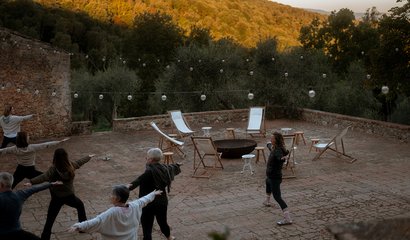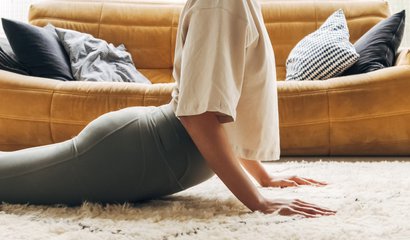Nov. 29, 2017
Sustainable Yoga Series: Warrior One
Over the years as my education and explorations with biomechanics deepens, there have been some poses that I no longer practice or teach, and others that I happily practice almost daily. Warrior One is one of my go-to, favourite postures.
Over the years as my education and explorations with biomechanics deepens, there have been some poses that I no longer practice or teach, and others that I happily practice almost daily. Warrior One is one of my go-to, favourite postures. And with just a little bit of tweaking from the traditional way of practicing, it is a pose that will keep the body strong and mobile for years to come with little wear and tear.
What I love about Warrior One is that it is a lunge. I remember when I was starting to practice yoga, my body was stiff and tight from years of voraciously reading books for hours on end (ie- sitting for hours on end) and then playing sports like rugby and track and field in high school. One of my clearest memories in my first yoga classes was how much I detested lunges. Oh those tight hips of mine! Of course over the years with continued practice, now lunges are a daily movement that I enjoy doing. Especially knowing down to the cellular level, how happy lunges make your body! Let's explore...
If we are purely going on visual cues, the traditional version sure looks prettier, all those nice curves and long lines. But to achieve those pretty lines, we are sacrificing some stability and increasing wear and tear in a variety of spots in the body. Remember as we go through this series that our body has the ability to move in all sorts of shapes, but it is the frequency of certain movements that creates imbalances and compensations in the body. So if you always practice your yoga asanas the same way every time, changing it up with mindful, biomechanically updated cues goes a long way to maintain a healthy body and mind!

Let's dissect the traditional cueing of the pose. The pink dots highlight some of the problem areas.
- Place your back heel down and turn your toes slightly out to the side.
- Square your hips forward.
Trying to "square the hips" with the foot anchored at that angle creates a LOT of strain on the knee of the back leg. Unless you are gumby, you are not going to be able to actually have your pelvis facing forward. As a result, with your foot fixed at that angle and moving your pelvis forward, something will have give to get you there and it will end up being your knee taking most of the movement.
- Lift your chest.
Lifting your chest is often ends up being a rib thrust. Which as mentioned previously in this series, the rib thrust compresses disks and promotes hyper-mobility in one or two vertabrae.
- Reach your arms up to the sky and look up.
We usually achieve reaching arms up to the sky through the help of that good 'ol rib thrust. And looking up to those hands compresses your cervical spine. Both these movement together potentially place a lot of strain to the lumber spine.

Updated Version:
- Tuck your back toes under.
- Keep your pelvis neutral.
By tucking the back toes under, it easily allows your pelvis to be in a more neutral position. What is neutral? You can use your ASIS (Anterior superior iliac spine- those two hip points at the front of your pelvis) as markers. Take your hands to the bones of your pelvis, find the ASIS and feel if one is higher than the other or if one if twisted slightly back. Try to arrange your pelvis so that the two points are more level. You'll need to bend your back leg to achieve a more neutral pelvis. Just this modification alone with the action of the pelvis and back leg get into some deeper muscle tissues that often get bypassed the traditional way.
- Keep your ribs down and reach your arms only as high as you can maintain your ribs over your pelvis.
Keeping your ribs down maintains core stability and no strain to your lumbar spine. By reaching your arms as high as they can go without the ribcage lifting up allows your arms to get a deeper, more effective stretch.
- Look straight forward.
Looking forward keeps your neck out of hyperextension. Yay! No compression in your cervical spine!
Mindfulness, curiosity and an open mind will help you progress your practice to one that is sustainable for the long-term. Enjoy exploring this new way of moving and practicing!
Curious about about a sustainable approach to yoga?
Join our online yoga studio feel the difference in your body



